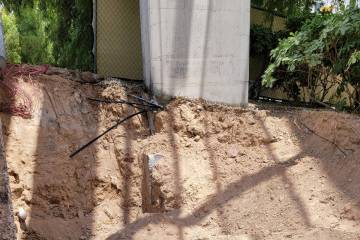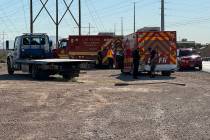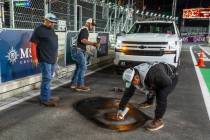Respiratory viruses fill pediatric ERs in Las Vegas Valley
Cases of RSV and other respiratory viruses are flooding pediatric emergency rooms in the Las Vegas Valley and filling up hospital pediatric floors, doctors said on Thursday.
Both the pediatric intensive care floor and pediatric general floor at St. Rose Dominican Hospital, Siena campus, in Henderson were full, said emergency department pediatrician Dr. Lyndsey van der Laan.
“We have no more beds,” she said. “Wait times in the ER are getting longer. We’re seeing more and more patients.”
Across the valley at Summerlin Hospital Medical Center, both the pediatric intensive care unit and floor also were at capacity.
“We’re continuing to open more rooms and more space so that we can accommodate the numbers of patients that are coming in,” said Dr. Robert Wilkinson, medical director of Summerlin’s pediatric emergency room.
Wilkinson said his ER is seeing a variety of respiratory viruses, including COVID-19 and flu, but “the vast majority are RSV.”
RSV — respiratory syncytial virus — is a common respiratory virus that usually causes mild, coldlike symptoms, with most people recovering in a week or two. But RSV can be serious, especially for younger children and older adults.
“The younger a child is, the more severe the illness can be,” Wilkinson said. “Premature babies especially are at risk of severe illness.”
Some parts of the country are experiencing the high volume of cases usually reserved for the peak of the RSV season, which typically occurs in December or January, said Kate Grusich with the Centers for Disease Control and Prevention.
The Southern Nevada Health District continues to see an increase in RSV cases in the community, representative Jennifer Sizemore said.
Wilkinson said Summerlin Hospital has been hit especially hard in the past few days.
The valley’s two children’s hospitals also are seeing high volumes.
University Medical Center Children’s Hospital is caring for a high number of pediatric patients with RSV and other respiratory viruses but continues to have beds available in general pediatrics and the pediatric ICU, representative Scott Kerbs said.
Sunrise Children’s Hospital “is experiencing record volumes of pediatric patients admitted with a respiratory diagnosis, specifically RSV,” chief medical officer Dr. Steven Merta said.
Few children who contract RSV will need emergency care.
“Most children, especially school-age children, are going to do just fine with the virus,” van der Laan said.
Children who are gasping for breath, breathing fast or otherwise showing signs of having trouble breathing “are the ones we want to see in the emergency department,” she said.
She advised parents to take off their child’s shirt to look at their rib cage and abdomen. Using extra muscles to breathe, sucking in their abdomen, bobbing their head or grunting can be signs of respiratory distress, she said.
“The younger they are, the harder the time they have managing their mucous,” she said. “Infants don’t know how to blow their nose.”
She encouraged parents to suction the nasal secretions of babies every couple of hours and before feedings. Staying hydrated is vital for thinning secretions. A humidifier or even a steamy bathroom can help a child breathe easier.
Parents also can look to their pediatrician or an urgent care for guidance on whether a visit to the ER is warranted.
”They can help navigate that uncertain water,” she said.
Contact Mary Hynes at mhynes@reviewjournal.com or 702-383-0336. Follow @MaryHynes1 on Twitter.























